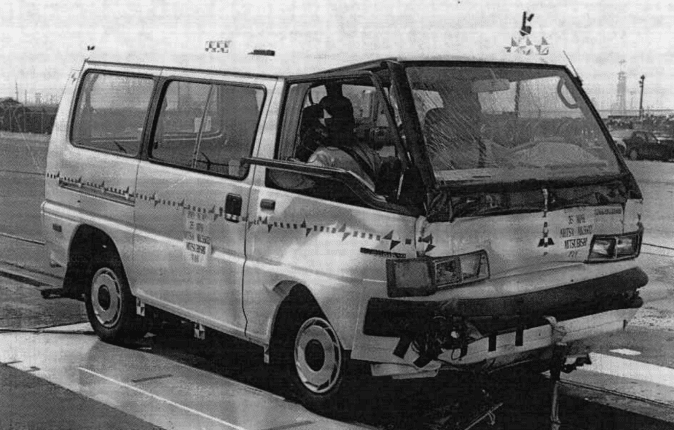Surprisingly Safe: The 1986-1991 Mitsubishi Van

The 1989 Mitsubishi Van after its 35-mph NHTSA frontal crash test.
Quick! What was the safest van in 1989? We’re not talking about minivans here, just the standard vans. If you racked your brain and thought “Did Volvo ever make a van?” before realizing that no, they didn’t, you would have probably guessed the Volkswagen Vanagon, especially if you’ve seen their videos about the safety of their then-current (T3 generation) van. Volkswagen certainly put a lot of engineering into, and made a big marketing deal about, the T3’s safety.
But if you wanted the safest van you could buy in 1989, as measured by NHTSA front crash tests, your Mitsubishi dealer would have been the best place to look. At this time, NHTSA had crash-tested 8 vans; the three full-size vans from the Big Three automakers, GM’s smaller Astro van, the Vanagon, and three Japanese offerings. Here they are, ranked by risk of severe injury for the worse occupant. The numbers at the far right are the HICs and chest G’s on the driver and passenger. All vehicles are 1989 models or vehicles tested in earlier years where the results still apply to the 1989 version.
Mitsubishi van – 19% driver risk, 18% passenger risk – 4 D /4 P stars – 805/49 D, 713/51 P
Nissan van – 28% driver risk, 9% passenger risk – 3 D / 5 P stars – 949/54 D, 597/36 P
Toyota van – 43% driver risk, 18% passenger risk – 2 D / 4 P stars – 1184/59 D, 530/54 P
Dodge Sportsman Van – 43% driver risk, 18% passenger risk – 2 D / 4 P stars – 983/68 D, 868/44 P
VW Vanagon – 52% driver risk, 20% passenger risk – 1 D / 4 P stars – 1320/59 D, 899/47 P
Chevy Astro – 87% driver risk, 86% passenger risk – 1 D / 1 P stars – 1849/64 D, 1838/64 P
Ford Club Wagon – 90% driver risk, 38% passenger risk – 1 D / 2 P stars – 1986/55 D, 1198/50 P
Chevy Sportvan – 100% driver risk, 60% passenger risk – 1 D / 1 P stars – 3665/97 D, 1452/56 P
Even if you add in the minivans of the time, Mitsubishi still comes in a very close second to the Plymouth Voyager van (results for which apply to all 1987-1990 model Chrysler minivans) which had an 18% driver risk and 13% passenger risk, with a driver HIC/Chest G of 903 and 43 and corresponding measurements of 501 and 47 for the passenger. The Aerostar did far worse, with a 66% risk for the driver and 36% for the passenger (worth 1 and 2 stars, respectively), with dummy measurements of 1,568 HIC / 50 Chest G’s for the driver and 1,071 HIC / 57 Chest G’s for the passenger.
All vans of the era did better for the driver than they did for the passenger.. While a majority of the vans afforded their passengers decent protection, among traditional vans, only Mitsubishi and Nissan fell below the values (a HIC of 1,000 and 60 Chest G’s) that would indicate a likelihood of serious injuries for the driver.
Something surprising was the Japanese vans were far and away the safest. The Vanagon ranked only 5th of the 8 vans, perhaps a consequence of its by-then aging design.






